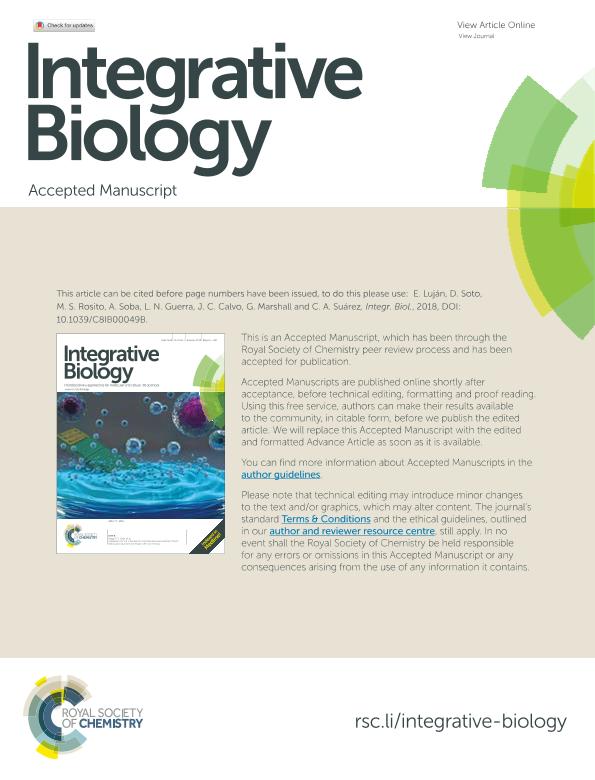Artículo
Microenvironmental influence on microtumour infiltration patterns: 3D-mathematical modelling supported by: In vitro studies
Luján, Emmanuel ; Soto, Daniela; Rosito, María Sol
; Soto, Daniela; Rosito, María Sol ; Soba, Alejandro
; Soba, Alejandro ; Guerra, Liliana Noemi
; Guerra, Liliana Noemi ; Calvo, Juan Carlos
; Calvo, Juan Carlos ; Marshall, Guillermo Ricardo
; Marshall, Guillermo Ricardo ; Suárez, Cecilia Ana
; Suárez, Cecilia Ana
 ; Soto, Daniela; Rosito, María Sol
; Soto, Daniela; Rosito, María Sol ; Soba, Alejandro
; Soba, Alejandro ; Guerra, Liliana Noemi
; Guerra, Liliana Noemi ; Calvo, Juan Carlos
; Calvo, Juan Carlos ; Marshall, Guillermo Ricardo
; Marshall, Guillermo Ricardo ; Suárez, Cecilia Ana
; Suárez, Cecilia Ana
Fecha de publicación:
05/2018
Editorial:
Royal Society of Chemistry
Revista:
Integrative Biology
ISSN:
1757-9694
Idioma:
Inglés
Tipo de recurso:
Artículo publicado
Resumen
Mathematical modelling approaches have become increasingly abundant in cancer research. Tumour infiltration extent and its spatial organization depend both on the tumour type and stage and on the bio-physicochemical characteristics of the microenvironment. This sets a complex scenario that often requires a multidisciplinary and individually adjusted approach. The ultimate goal of this work is to present an experimental/numerical combined method for the development of a three-dimensional mathematical model with the ability to reproduce the growth and infiltration patterns of a given avascular microtumour in response to different microenvironmental conditions. The model is based on a diffusion-convection reaction equation that considers logistic proliferation, volumetric growth, a rim of proliferative cells at the tumour surface, and invasion with diffusive and convective components. The parameter values of the model were fitted to experimental results while radial velocity and diffusion coefficients were made spatially variable in a case-specific way through the introduction of a shape function and a diffusion-limited-aggregation (DLA)-derived fractal matrix, respectively, according to the infiltration pattern observed. The in vitro model consists of multicellular tumour spheroids (MTSs) of an epithelial mammary tumour cell line (LM3) immersed in a collagen I gel matrix with a standard culture medium ("naive" matrix) or a conditioned medium from adipocytes or preadipocytes ("conditioned" matrix). It was experimentally determined that both adipocyte and preadipocyte conditioned media had the ability to change the MTS infiltration pattern from collective and laminar to an individual and atomized one. Numerical simulations were able to adequately reproduce qualitatively and quantitatively both kinds of infiltration patterns, which were determined by area quantification, analysis of fractal dimensions and lacunarity, and Bland-Altman analysis. These results suggest that the combined approach presented here could be established as a new framework with interesting potential applications at both the basic and clinical levels in the oncology area.
Archivos asociados
Licencia
Identificadores
Colecciones
Articulos(CSC)
Articulos de CENTRO DE SIMULACION COMPUTACIONAL P/APLIC. TECNOLOGICAS
Articulos de CENTRO DE SIMULACION COMPUTACIONAL P/APLIC. TECNOLOGICAS
Articulos(IAFE)
Articulos de INST.DE ASTRONOMIA Y FISICA DEL ESPACIO(I)
Articulos de INST.DE ASTRONOMIA Y FISICA DEL ESPACIO(I)
Citación
Luján, Emmanuel; Soto, Daniela; Rosito, María Sol; Soba, Alejandro; Guerra, Liliana Noemi; et al.; Microenvironmental influence on microtumour infiltration patterns: 3D-mathematical modelling supported by: In vitro studies; Royal Society of Chemistry; Integrative Biology; 10; 5; 5-2018; 325-334
Compartir
Altmétricas



